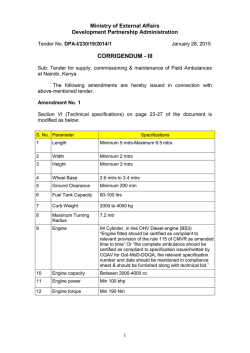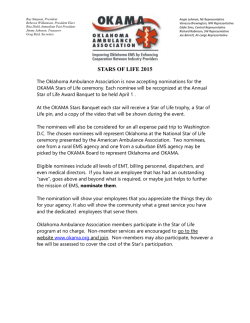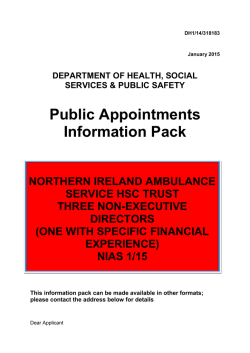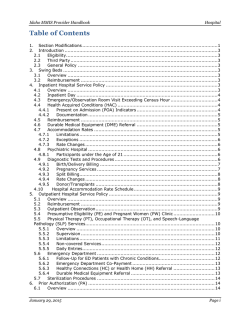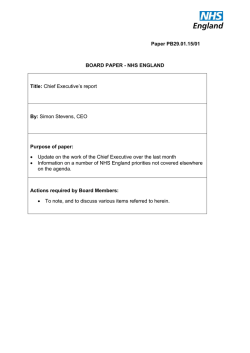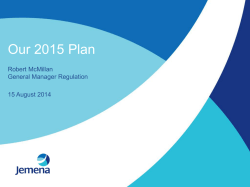
169.5 KB - Productivity Commission
Steering Committee for the Review of Government Service Provision F act she e t Under embargo until 12.15 am, Friday 30 January 2015 For personal use only. Third parties should not be approached until the embargo is lifted. Report on Government Services 2015 FIRE AND AMBULANCE SERVICES: AMBULANCE EVENTS (CHAPTER 9) This chapter reports on the performance of governments in providing emergency management services provided in the event of fire and out of hospital medical emergency events. This factsheet focuses on ambulance services for out of hospital medical emergency events. • Ambulance events are incidents that result in demand for ambulance services. Ambulance services include preparing for, providing and enhancing: emergency and non-emergency pre-hospital and out-of-hospital patient care and transport; inter-hospital patient transport; specialised rescue services; ambulance services to multi-casualty events; and capacity building for emergencies (p. 9.39). Nationally, in 2013-14, there were 3.1 million incidents resulting in 4.2 million ambulance service responses to attend to 3.2 million patients (p. 9.41). • Performance reporting for ambulance events includes information on ambulance service organisations as the primary agencies involved in providing services for ambulance events. Recurrent expenditure across Australia was approximately $2.7 billion (or $114 per person) in 2013-14 (p. 9.67). Nationally, there were 15 503 full time equivalent paid personnel, 5972 volunteers and 2456 community first responders in ambulance service organisations in 2013-14 (p. 9.41). (Community first responders are trained volunteers that provide an emergency response (with no transport capacity) and first aid care before ambulance arrival.) Objectives of emergency services for ambulance events The objectives of government involvement in ambulance service to provide pre-hospital and out-of-hospital care and patient transport services, that: • are high quality, timely, and meet clients’ needs through delivery of coordinated and responsive health care • are equitable and accessible • are effectively, efficiently and sustainably delivered • reduce the adverse effects of emergency events on the community by providing specialised medical care in emergency situations (p. 9.44). [MORE] Page 1 of 2 Performance indicators for ambulance events (figure 9.22, p. 9.45) Response locations p. 9.46 Equity Availability of ambulance officers/paramedics p. 9.48 Access Urban centre response times p. 9.51 State-wide response times p. 9.55 Objectives Access PERFORMANCE Triple zero call answering time p. 9.57 To be developed Cardiac arrest survived event p. 9.70 Safety Clinical incidents Cardiac arrest survival to hospital discharge Clinical Clinical interventions and treatments Appropriateness Quality Effectiveness Responsiveness Pain management p. 9.72 Continuity of care Continuity Workforce by age group p. 9.62 Staff attrition p. 9.63 Sustainability Level of patient satisfaction p. 9.74 Enrolments in paramedic training p. 9.64 Ambulance services expenditure per person p. 9.66 Efficiency Expenditure per urgent and non-urgent response Key to indicators* Outputs Text Outputs Most recent data for all measures are comparable and complete Text Most recent data for at least one measure are comparable and complete Text Most recent data for all measures are either not comparable and/or not complete Text No data reported and/or no measures yet developed Outcomes Outcomes * A description of the comparability and completeness of each measure is provided in indicator interpretation boxes within the chapter Background information: Lawrence McDonald, Head of Secretariat 03 9653 2178 / 0421 584 905 Other information: Media and Publications 03 9653 2244 Please do not approach other parties for comment before 30 January 2015. This volume can be accessed via the Productivity Commission’s website on the morning of Friday 30 January 2015: www.pc.gov.au. Hard copies of this volume will also be available for purchase via the Commission’s website. Tables with a ‘9A’ prefix (eg table 9A.5) are in the attachments on the Review website. [END] Page 2 of 2
© Copyright 2025
